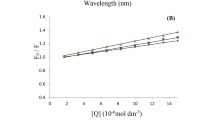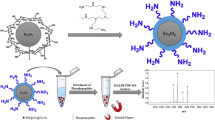Abstract
Chromatographic studies were performed to measure myelin basic protein (MBP) interactions by covalently binding a number of different proteins to Sepharose and passing radioactive bovine MBP over these columns. Studies at a variety of pH values, ionic strengths and temperatures revealed that the bovine MBP could interact with itself as well as cytochrome c, lysozyme, and ovalbumin. Chromatographic profiles of elution volume vs. pH revealed that the interaction between MBP and these immobilized proteins was biphasic. The self-association of MBP was found to be strongest between pH 7.4 and 8.1 and at an elevated temperature. Titration of the amino acid residues responsible for the association of MBP with other proteins revealed apparent pKs ranging from 6.10 to 6.70. A pH dependence study at an elevated temperature shifted the apparent pK of the MBP interaction to a lower value with all the proteins except ovalbumin. After destroying 60% of the histidine residues in MBP by photooxidation and passing125I-labeled photooxidized MBP over Sepharose columns containing immobilized protein, the second phase in binding was decreased significantly with immobilized cytochrome c, lysozyme, and MBP and to a smaller extent with ovalbumin. These results are consistent with the involvement of deprotonated histidine residues in the MBP-protein associations.
Similar content being viewed by others
References
Crang, A. J., and Rumsoy, M. G. 1977. The labeling of lipid and protein components in isolated central nervous system myelin with dansyl chloride. Biochem. Soc. Trans. 5:110–112.
Rumsby, M. G. and Crang, A. J. 1977. The myelin sheath—a structural examination. Pages 247–362, in Poste, G. and Nicholson, G. L. (eds). Cell Surface Reviews, Vol. 4 North Holland, New York.
Carnegie, P. R., and Moore, W. J. 1980. Myelin basic protein. Pages 120–143, in Bradshaw, A. and Schneider, M. (eds.), Proteins of the nervous system. Raven Press, New York.
Braun, P. E. 1977. Molecular architecture of myelin. Pages 91–115, in Morell, P. (ed.), Myelin. Plenum Press, New York.
Boggs, J. M., Moscarello, M. A., and Papahadjopoulos, D. 1982. Structural organization of myelin—Role of lipid-protein interactions determined in model systems. Pages 1–51, in Jost, P. C. and Griffith, O. H. (eds.), Lipid protein interactions, Vol. 2. John Wiley and Sons, New York.
Smith, R. 1982. Self-association of myelin basic protein: Enhancement by detergents and lipids. Biochemistry 21:2697–2701.
Burns, P. F., Campagnoni, C. W., Chaiken, I. M., and Campagnoni, A. T. 1981. Interactions of free and immobilized myelin basic protein with anionic detergents. Biochemistry 20:2463–2469.
Lampe, P. D., Wei, G. J., and Nelsestuen, G. L. 1983. Stopped-flow studies of myelin basic protein association with phospholipid vesicles and subsequent vesicle aggregation. Biochemistry 22:1594–1599.
Golds, E. E., and Braun, P. E. 1978. Protein associations and basic protein conformation in the myelin membrane. The use of difluorodinitrobenzene as a cross-linking reagent. J. Biol. Chem. 253:8162–8170.
Golds, E. E., and Braun, P. E. 1978. Cross-linking studies on the conformation and dimerization of myelin basic protein in solution. J. Biol. Chem. 253:8171–8177.
Smith, R. 1980. Sedimentation analysis of the self-association of bovine myelin basic protein. Biochemistry 19:1826–1831.
Smith, R. 1977. Non-covalent cross-linking of lipid bilayers by myelin basic protein. A possible role in myelin formation. Biochim. Biophys. Acta. 470:170–184.
Smith, R. 1977. The secondary structure of myelin basic protein extracted by deoxycholate. Biochim. Biophys. Acta 491:581–590.
Boggs, J. M., and Moscarello, M. A. 1978. Effect of basic protein from human central nervous system myelin on lipid bilayer structure. J. Membrane Biol. 39:75–96.
Lampe, P. D., and Nelsestuen, G. L. 1982. Myelin basic protein-enhanced fusion of membranes. Biochim. Biophys. Acta 693:320–325.
Liebes, L. F., Zand, R., and Phillips, W. D. 1975. Solution behavior, circular dichroism and 220 MHz PMR studies of the myelin basic protein. Biochim. Biophys. Acta 504:27–39.
Chapman, B. E., and Moore, W. J. 1976. Conformation of myelin basic protein in aqueous solution from nuclear magnetic resonance spectroscopy. Biochem. Biophys. Res. Commun. 73:758–766.
Smith, R., and McDonald, B. J. 1979. Association of myelin basic protein with detergent micelles. Biochim. Biophys. Acta. 554:133–147.
Reidl, L. S., Campagnoni, C. W., and Campagnoni, A. T. 1981. Preparation and properties of an immunosorbent column specific for the myelin basic protein. J. Neurochem. 37:373–380.
Barylko, B., and Dobrowolski, Z. 1984. Ca2+-camodulindependent regulation of F-actin-myelin basic protein interaction. Eur. J. Cell. Biol. 35:327–335.
Campagnoni, A. T., Whitehead, D. L., and Rowan, R., III. 1978. Nuclear magnetic resonance studies of myelin basic proteins. Pages 413–421, in Agris, P. F., Loeppky, R. M., and Sykes, B. D. (eds.), Biomolecular structure and function. Academic Press, New York.
Campagnoni, C. W., Carey, G. D., and Campagnoni, A. T. 1978. Synthesis of myelin proteins in the developing mouse brain. Arch. Biochem. Biophys. 190:118–125.
Craig, L. C. 1967. Techniques for the study of peptides and proteins by dialysis and diffusion. Pages 870–905, in Hirs, C. H. W. (ed.), Methods in Enzymology, Vol 11, Academic Press, New York.
Panyim, S., and Chalkley, R. 1969. High resolution acrylamide gel electrophoresis of histones. Arch. Biochem. Biophys. 130:337–346.
Weber, K., and Osborn, M. 1969. The reliability of molecular weight determinations by dodecyl sulfate-polyacrylamide gel electrophoresis. J. Biol. Chem. 244:4406–4412.
Elliott, J. I., and Brewer, J. M. 1979. The relation of photooxidized histidines in yeast enolase to enzymatic activity. Arch. Biochem. Biophys. 192:203–213.
Cuatrecasas, P., and Anfinsen, C. G. 1971. Affinity chromatography. Pages 345–378, in Jakoby, W. B. (ed.), Methods in Enzymology, Vol 22. Academic Press, New York.
Lowry, O. H., Rosebrough, N. J., Farr, A. L., and Randall, R. J. 1951. Protein measurement with the Folin phenol reagent. J. Biol. Chem. 193:265–275.
Havekes, L., Buckmann, F., and Visser, J. 1974. Immobilized glutamate dehydrogenase: Some catalytic and structural aspects. Biochim. Biophys. Acta 334:272–286.
Failla, D., and Santi, D. V. 1973. A simple method for quantitating ligands covalently bound to agarose beads. Anal. Biochem. 52:363–368.
Haworth, W. N., and Jones, W. G. M. 1944. The conversion of sucrose into furan compounds. Part I. 5-Hydroxymethylfurfuraldehyde and some derivatives. J. Chem. Soc. 81:667–670.
Jencks, W. P. 1959. Studies on the mechanism of oxime and semicarbazone formation. J. Amer. Chem. Soc. 81:475–481.
Koelsch, R., Lasch, J., Marquardt, I., and Hanson, H. 1975. Application of spectrophotometric methods to the determination of protein bound to agarose beads. Anal. Biochem. 66:556–567.
Chapman, B. E., Littlemore, L. T., and Moore, W. J. 1978. Conformation of myelin basic protein and its role in myelin formation. Pages 207–220, in Palo J. (ed.), Myelination and demyelination. Plenum Press, New York.
Boggs, J. M., and Moscarello, M. A. 1978. Structural organization of the human myelin membrane. Biochim. Biophys. Acta 515:1–21.
Davison, A., 1970. Myelination pp. 80–161. The biochemistry of the myelin sheath. Pages 50–161, in Kugelmass, I. N. (ed.), Myelination. Charles C. Thomas, Springfield, IL.
Greenstein, J. P. 1933. Studies of the peptides of trivalent amino acids. J. Biol. Chem. 101:603–621.
Nozaki, Y., and Tanford, C. 1971. The solubility of amino acids and two glycine peptides in aqueous ethanol and dioxane solutions: Establishment of a hydrophobicity scale. J. Biol. Chem. 246:2211–2217.
Author information
Authors and Affiliations
Rights and permissions
About this article
Cite this article
Moskaitis, J.E., Shriver, L.C. & Campagnoni, A.T. The association of myelin basic protein with itself and other proteins. Neurochem Res 12, 409–417 (1987). https://doi.org/10.1007/BF00972291
Accepted:
Issue Date:
DOI: https://doi.org/10.1007/BF00972291




